 |
| Bubble Eye Goldfish |
2018-11-14
2018-11-13
Six Reasons Why You Should Never Neglect CHANGING WATER In Your Aquarium Tank
pH Control – pH stands for hydrogen potent. It is actually the concentration of hydrogen ions present in your aquarium tank, and as you know, hydrogen ion concentration refers to acidity of the water in the tank. As fishes live in the water, performing all their biological activities, the pH value is bound to change. The best way to ensure that the pH values remain conducive for the health of your fish is to change the water often.
Kh control – For the scientifically inclined people, Kh is the hydrolysis constant. Simply speaking, it is the ability of water to buffer, which means, maintain a particular optimum level of the acids and bases in it. Changes occur in the fish tank over time due to the inclusion of chemicals produced from biological activity. That is one reason why the water has to be periodically changed.
Controlling nitrate levels – Ideally speaking, a saltwater aquarium must have a nitrate concentration of at the most 20 parts per million and a freshwater aquarium must have at the most 50 parts per million. Fish excretion is in the form of ammonia, which increases the nitrate level of the tank. There are protein skimmers available that can help to keep the nitrate levels to optimal levels within the tank. But these skimmers will not be able to remove the organic debris that collects in the tank from time to time. That is the reason why complete water changes become necessary. In fact, aquarium sellers do stress upon nitrate level maintenance as the most important reason for making periodical water changes.
Detoxifying the aquariums – Dead aquatic organisms, byproducts of metabolic activities in the fish and other aquarium residents and the excretion products of your fish will definitely introduce some toxic products in your aquarium tank. Some toxic materials can also enter from the external environment, such as when things drop into your tank or when some microorganisms enter through the air. They could play havoc with the health of your delicate fish. You cannot effectively monitor such toxic intrusions. The best way is to change water.
Cleaning aquarium accessories – If you have live elements in your aquarium tank such as live sand, live rock, sponges, bio balls, etc. it is best to provide them with clean water of aquarium standard to filter out the wastes that they produce from time to time.
Controlling algal growth – Algae are microscopic plants that grow in all types of aquatic environment. They grow faster in aquariums because the water there is stagnant and favorable for their growth. However, algae can pollute the water in the closed environment to drastic levels, which could also mean health problems to your fish. Not only that, algae will compete with the fish with the resources available in your aquarium. If you change the water from your aquarium regularly, you are also removing the algae that have grown in them.
Hence, water changes in your aquarium are a very important aspect of aquarium cleaning. They ensure that your fish live longer and healthier in the home you provide them.
2018-11-12
Fact Sheet: DISCUS FISH - Symphysodon aequifasciatus
(Original Title: A Reference Guide for Symphysodon Aequifasciatus (Discus))
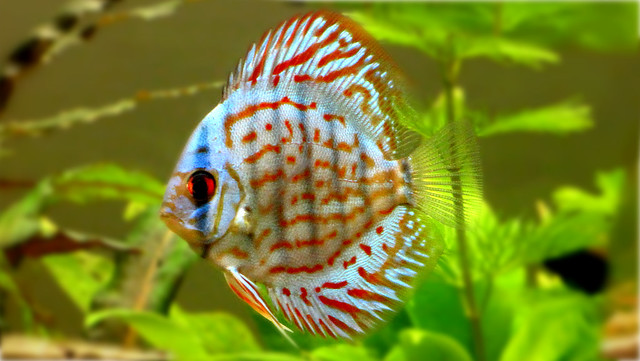 |
| Photo by Rego – d4u.hu |
Symphysodon aequifasciatus (Discus)
Class: Actinopterygii (ray-finned fishes)
Order: Perciformes (perch-like fish)
Family: Cichlidae
Scientific Name: Symphysodon aequifasciatus
Other Scientific Name(s): Symphysodon aequifasciata, Symphysodon discus aequifasciata, Symphysodon aequifasciatus aequifasciatus, Symphysodon discus tarzoo, Symphysodon aequifasciata axelrodi, Symphysodon aequifasciata haraldi
Common Name: Discus
Range: South America: Brazil, Peru. Found on Amazon and Solimoes rivers of Brazil, from the lower Rio Putumayo-Ica and from Benjamin Constant to Belém. Has been introduced to the Rio Nanay in Peru.
Diet: Carnivorous. Frozen foods preferred, but will accept flake foods. Particularly like red bloodworms, but feeding "live" food is not recommended. Red worms, etc, should only be fed to discus once every other day. Beware of parasites or bacteria in the discus tank from live foods!
Temperament: Timid of strangers. Easily frightened, unless placed in a high traffic area. Can be very friendly to aquarist, oft-times eating out of the hand. If given a place to hide, they will tend to do so.
Sexing: Discus are hard to sex unless breeding. Normally, the male will be larger and will present with longer fin extensions and a wider forehead.
Breeding: Buy either proven pairs or a group of young fish and allow them to pair themselves. The eggs are laid on a breeding cone. A clay flowerpot turned upside down works well. The fry must be kept with the parents after hatch, as they "feed" off the body slime of the parents. Special care must be taken to ensure that fry does not injure the parents when getting larger. Watch for marks on the body of the pair, and if it begins to occur, the fry is ready to be moved to a community tank on their own. If left w/ the pair, serious injury can result.
Special Care: If kept specifically for breeding, a bare-bottomed tank is highly recommended.
Other Comments: To keep Discus well, water conditions are absolutely crucial. A PH of 6.3 to 6.9 is the optimal level for keeping discus.
Water Temperature: Discus like it warm. They come from the Amazon basin, so water temps for these fish should be 80-84 degrees F, although some aquarists set the temperature as high as 90 degrees F.
By Alden Smith
Alden Smith is a published author and has been marketing on the internet for 7 years. His website, King Discus, is an active gathering place for discus breeders and lovers of discus fish.
Article Source: EzineArticles
|
2018-11-10
Fact Sheet: CHERRY BARB - Puntius titteya
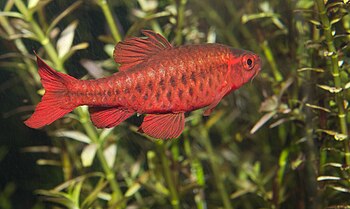 |
| Cherry barb, Puntius titteya (Photo credit: Wikipedia) |
The Cherry Barb grows to about two inches (5cm) long. The average lifespan of this fish is about four years, but some have been recorded up to seven years old.
Threatened Species
This fish is threatened in the wild. Juniper Russo Tarascio in his excellent article on Associated Content:
"The Cherry Barb: A Threatened Freshwater Aquarium Fish" puts its rarity down to overfishing for the Aquarium Trade. Although this may certainly have been a factor in the reduction in numbers of this fish, my own research suggests that the continuing problems the wild population of the Cherry barb are more to do with the destruction of habitat rather than overfishing.
In our own shop, all these species (and nearly all the fish) are bred in captivity.
Water Conditions
The Cherry Barb will be happy at a temperature of 24 degrees C (75 degrees F), with a pH of 7 and soft to moderate hardness. Nowadays, practically all the Cherry Barbs offered for sale are captive bred ones, and like many captives bred fish tend to be able to adapt to a wider range of conditions than the wild ones could. However, particularly for this fish, do not change the water temperature or chemistry too quickly.
The Tank set up should have plants, preferable growing right up to the surface, and some clear section for swimming.
Food
Like most fish, Cherry Barbs are omnivores. In the wild, they will eat insect larvae, especially the young of mosquitoes, algae, and a wide range of other things of the right size. In the aquarium, they will eat all normal fish foods and are an easy fish to feed.
Like nearly all aquarium fish, they appreciate the occasional feed of live food like daphnia or wrigglers. Good frozen foods like frozen bloodworms are a good treat.
Companions
The Cherry Barb is not a fish that forms a very tight school. Nevertheless, if only one is kept it tends to be stressed. I recommend a group of at least six.
It is one of the most peaceful barbs, and I have kept them even with slow, moving long finned fish like Siamese Fighting Fish, Guppies and Endlers Guppies.
Cherry Barbs are also happy with other small reasonably peaceful fish.
I have also kept them with slightly more aggressive fish like Paraguay Tetras, Buenos Aires Tetras, Colombian Tetras, Rosy Barbs, and Tiger Barbs, but I would hesitate to recommend these fish as companions for Cherry Barbs. I suggest caution with these fish.
Sexing
The Male Cherry Barbs are a much more definite cherry color than the females which are more faded in color. The females tend to be plumper.
Breeding
The Cherry Barb is an egg-laying species, producing something like 200 eggs from one female. This fish spawns readily. A fine-leaved plant in the breeding aquarium will increase the chances of them laying.
The eggs hatch in about one day. The parents eat their own eggs as well as the young babies, so to have much chance of raising the young, the parents need to be removed as soon as possible after spawning.
An alternative way of breeding it is simply to keep a small group of them in a large aquarium with a lot of plants, and no other fish. Under these conditions, many of the eggs and fry will get eaten, but some may survive. This is a little closer to what would happen in the wild.
Pest Fish
Although I do not have evidence that the Cherry Barb is a pest fish anywhere, any fish introduced into a foreign ecosystem can damage it. The fact that it is not common in its native area is not a good reason to put it into inappropriate places in the wild.
2018-11-09
Finding a Pet POISON DART FROG
 |
| Poison Dart Frog (Dendrobates auratus) (Photo credit: Wikipedia) |
Inhabiting countries of South and Central America like Costa Rica, Columbia, Bolivia and Peru, the poison dart frog is a stunning, bright colored frog that secretes a poisonous toxin. The science community only discovered this unique frog in the 1960's, but it has been known by tribes for many years. By the name of the frog, one might think that it is somehow able to shoot poisonous darts, but this is simply not the case. The poison dart naming comes from the fact that tribes in the rainforest used the poison on the tips of darts that they would use to subdue a threat.
The poison dart frog is not just one frog, but an entire species of frogs that contains well over 100 individual types of poison dart frogs. Usually, these frogs are quite small and measure less than 1 inch long, but some species can grow up to about 2.5 inches.
While the poison in many species of poison dart frogs may not be enough to kill a healthy human, there have been instances where the poison entered a cut or scratch which resulted in death. Their poison is quite effective in subduing their predators, however, if a poison dart frog is born in captivity, it's unlikely that they will contain any poison. The poison that is developed in the frog while out in the wild is because of it's diet of ants, termites, beetles and other insects. When they no longer eat the poisonous beetles of Central America, the toxins in their body are no longer produced, making them harmless.
Most of us are accustomed to seeing frogs at the edge of a pond, marsh or stream, but the dart frog is different. It does not have webbed feet and is therefore not a good swimmer so you won't find one of these frogs living in ponds.
Unfortunately, the Poison Dart frog is experiencing a population crisis and is on the endangered species list. Over the years, destruction of rainforest land as well as droughts in their regions, these frogs have decreased in numbers. Fortunately, pet Poison Dart Frogs are bred only in captivity and are not collected from the wild.
The bright colors of these frogs are just incredible and it's no wonder why people want to keep them as pets. With proper care, the Poison Dart Frog can live for many years in captivity.
|
2018-11-08
MYSTIC AQUARIUM: An Oasis of Wonderful Sea Creatures
 |
| Photo by bunnygoth |
The famous “island of life” which is Ocean Planet Pavilion has also improved. With new graphics and layout, you will not only enjoy the majestic scene but you will be amazed at how these spectacular facilities are made. You will see four exhibits that feature all forms of marine life.
The river in this particular area carries 400 million tons of organic materials used as a habitat that supports different forms of marine life. You will also like this particular site as it appears to be real especially if birds are around. Children and adult are able to get close to marine creatures such as sea horses, crabs, mudskippers, octopus and many more famous aquatic living things.
You will also love the coral reefs found underwater. This is one of the favorite attractions. Almost 28 foot and 30,000 gallon of a tank is the habitat for different types of fishes swimming around the brightly colored coral reefs. The reefs may appear to be real. Many are fascinated upon knowing that these coral reefs are only artificial.
You will also find coral polyps under the water scene. These are small and soft-bodied animals living in colonies. They are made up of calcium carbonate and in a longer period of time, it grows bigger and bigger forming shapes. They are called coral reefs.
It also serves as an educational venue for students. Mostly, it is visited by many students for educational tours and research. With plenty of species, the student will be in touch with all the marine creatures from around the world. They do not need to go to different places on the planet to appreciate them.
If you are curious about the place, visit it now and experience a once in a lifetime opportunity to get close with all the marine creatures from around the world. You will miss half of your life if you do not move now.
2018-11-06
2018-11-05
Maintaining LIVE AQUARIUM PLANTS
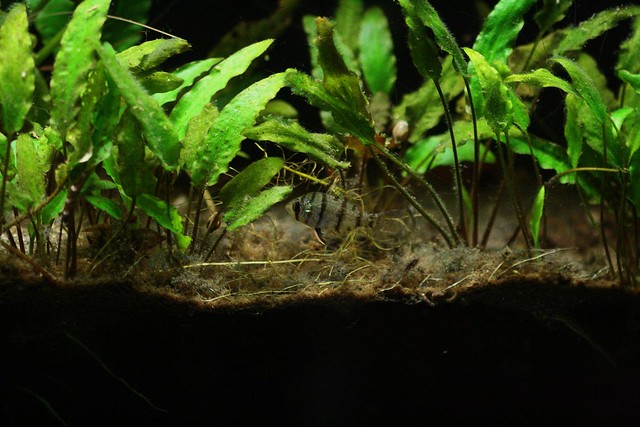 |
| Photo by scott361 |
Plants need Carbon Dioxide to grow.
Carbon dioxide (CO2) is the most important nutrient that you need to keep aquarium plants healthy. CO2 is produced by the waste products within the fish tank, like fish excrement, excess food and as a by-product of bacterial action but this is often not sufficient to keep plants in good condition.
Therefore many people utilize a system that puts CO2 into the aquarium. CO2 systems come in a variety of shapes and sizes but can be split into two simple types. Those that provide a constant source of CO2 and those that can regulate the CO2.
It is a good idea to regulate the CO2 either using the system or manually because fish will suffer if there is too much CO2 in the water. Rough guides for carbon dioxide suggest that 30 to 45 mg per liter of water is enough for plants to thrive but over 100mg per liter is too much for fish.
Plants need an adequate lighting source.
CO2 systems must be synchronized with the lighting system that you use in the aquarium. Light is a vital part of the photosynthesis process which plants use to turn light energy into chemical energy that they use to grow. Normally plants would derive the light source from the sun but in the case of aquarium plants, the sun may not be available so an artificial source is needed. The light source should provide a full spectrum of light to the plants. Popular types are mercury vapor or metal halide lights
Plants need a good substrate.
A substrate is the type of gravel or sand that you use in the fish tank. The substrate must be deep enough to allow the roots of plants to take hold and keep the plant firmly attached. You want the substrate to have a depth of about 8 cm.
Substrates can also be nutrient rich so they can help to keep the plants healthy but they must not alter the quality of the water. For example, lime based substrates will make the water harder or more alkaline. Most fish have a preference for soft or hard water if the water was to change due to the substrate the fish could become stressed or ill.
Many Aquarists use layers of a substrate to get around this problem. If a fish likes soft water then the top layer of the substrate would be a lime-free gravel. Under the lime-free gravel, a liner layer of nutrient-rich gravel could be used.
Summary.
Carbon dioxide, a good light source and a nutrient rich substrate are important components in maintaining live aquarium plants. Liquid fertilizers can also be used if you feel that the plants look in poor condition.
|
2018-11-03
AERATION: - essential factor to aquarium fish.
As we all know rivers and lakes are the natural habits for fish and other marines. Rivers and lakes have a large surface area which makes maximum provision of oxygen for fish survival possible. On the other hand, the aquarium is not like a river or lake, it has a smaller surface area and there is a limited movement of habitats.
This makes provision of alternative means of oxygen for fish to breathe importantly. This artificial process of providing oxygen is called aeration. It's a simple process of re-oxygenating the water in the aquarium tank.
The Aerating System:
This is the series of material that increases the supply of air (thereby increasing oxygen concentration) they are:
- the air pump
- t-pieces
- rubber tubing
- clamp or regulator
- diffusers or airstone
Air pumps come in different shapes and sizes but the most popular ones are tecax air pump from Taiwan together with 'Dyna free, and the dragon' another popular one is super 555 from India though cheaper, but not as rugged. Occasionally available are the more expensive whisper and rens air pumps from Uk and rance respectively. Always place air pumps above the water level hooked to a non-vibrating material.
You can accomplish aeration in your aquarium tank by using the above-listed aeration materials. This materials form the aeration system. For small tanks, all you need is to attach simple aquarium air pump to airstone by means of rubber air tube. The system will be blowing air into the water which causes motion in the aquarium tank and thus provide necessary oxygen your fish needs to breathe in the aquarium.
2018-11-01
Mouth Brooding AFRICAN CICHLIDS
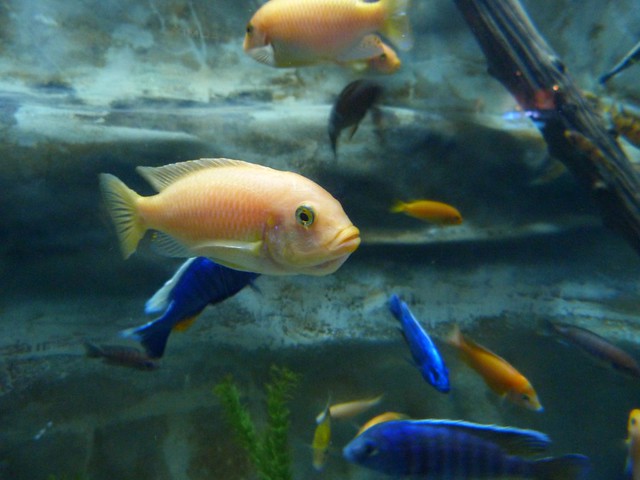 |
| Photo by Rusty Clark – hottnfunkyradio.com |
Most African Cichlids are what's called "maternal mouthbrooders." Mouthbrooders are highly advanced from an evolutionary standpoint. They've developed a technique for protecting their young along at the most vulnerable time in their development. Mouthbrooders brood their eggs within their mouths!
For many of the non-mouthbrooding cichlids, and that is most neotropical cichlids, more or less stable pairs are formed and maintained through pair-bonding behaviors. Such behaviors as jaw locking, gill flaring (frontal displays) and beating/circling (lateral displays) function permitting inspection and "testing" of potential mates. This behavior will continue, following the establishment of any pair bond, as a ritualistic recognition or greeting behavior reaffirming that bond.
There isn't any best or right setup and design for cichlids. You can find however designs which may be better suited to your cichlids and make them feel more at home. If you're interested in seeing natural behaviors from the fish you should try to design your aquascape to mirror the environment your fish would live in if it were wild.
Not every setup will work with every cichlid. One example is an exceptionally rocky African Mbuna setup will not make a South American or even an African hap very happy. Many individuals who keep fish think cichlids are difficult to take care of, but Cichlids are easy to maintain once you learn how to keep them healthy and stress-free. 90% of issues with cichlids start with stress, tank mates, pH levels, and feeding them the wrong food.
To acquire more information about the technicalities of keeping cichlids, read Cichlid Fish Secrets. It's very professionally written and very easy to read whatever experience level, which is loaded from start to finish with relevant, detailed, and simple reading information.
|
2018-10-30
Characteristics Of The SERPAE TETRA Fish
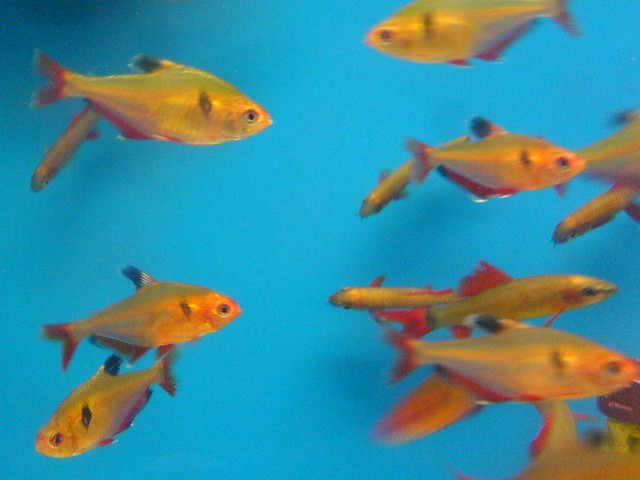 |
| Photo by dmott9 |
Originally from South America, Peru and the Amazon River basin, the serpae tetra fish is sleek, tall and compressed. A serpae tetra fish typically grows up to 2.2 inches long. The female serpae tetra fish is generally a bit more rounded than its male counterpart. The color of the serpae tetra fish's body can range from bright red to reddish brown. The serpae tetra fish's ventral and anal fins are red. Its dorsal fin, however, is black with white fringing. A black spot can be found behind its gill cover. As the serpae tetra fish ages, this black spot slowly become smaller.
If you are thinking of getting serpae tetras, make sure that your aquarium is well planted. Serpae tetras love live plants and driftwoods. While the serpae tetra fish can tolerate being in an aquarium with low temperatures, it is best that you keep the temperature between 68 and 82 degrees Fahrenheit to keep your serpae tetra fish happy.
The serpae tetra fish is an easy fish to care for and to feed. A serpae tetra fish will eat everything from flakes to live, freeze-dried and frozen foods. Give your serpae tetra a variety of diet. If you have several serpae tetras, you will notice that they will nip at each other's fins while you feed them in an effort to grab for food.
Serpae tetras are community fish. However, it is recommended that you do not mix your serpae tetra fish with neon tetra fish because serpae tetra fish can be a bit too aggressive for the neon tetra fish to handle.
You will typically find serpae tetras swimming in the middle and bottom areas of the aquarium tank. In general, serpae tetras do not bother other fish in the tank. However, serpae tetras love to play with and chase each other around the tank.
|
2018-10-29
Pet JELLYFISH Facts: Moon Jellies (Aurelia Aurita)
 |
| A Moon Jellyfish. (Photo credit: Wikipedia) |
Moon jellies are the easiest jellyfish to keep alive in captivity. This is because of their diversity in nature. Moon jellies can be found in almost every ocean in the world. Their natural habitat stretches from the equator as far north as 70 latitudes and as far south as 40 in every ocean that falls within those geographic parameters.
They are prominent in the shallow coastal waters of estuaries and harbors which explains their abundance in what is still an infant branch within the larger saltwater aquarium trade industry. Because they are common in both temperate and tropical water, they can tolerate temperature ranges anywhere between 42-88 F (6-31 C). Although they can survive in brackish water, a salinity level (specific gravity) of 1.023 will mimic their native marine environment.
The name moon jellyfish is purely descriptive. They are named for the most prominent part of their anatomical makeup, their large disk or full moon shaped bell. They can be further distinguished by the four horseshoe-shaped gonads at the center of their bell. These reproductive organs resemble the craters found on the moon. These fish are very popular as pets because they are transparent and will appear to glow in whatever color is shined through them. They look particularly stunning in an aquarium with an LED fader system set up in it.
Another point in their favor is that their stinging cells do not produce enough pressure to pierce human skin. In the wild, a moon jelly's life cycle is limited to one year from start to finish. In captivity, they can easily live up to three years. These jellies can grow up to one foot in diameter.
Another point in their favor is that their stinging cells do not produce enough pressure to pierce human skin. In the wild, a moon jelly's life cycle is limited to one year from start to finish. In captivity, they can easily live up to three years. These jellies can grow up to one foot in diameter.
In nature, moon jellies spend most of their time drifting on currents rather than swimming. In captivity, they will require an aquarium with a well-designed turbulence system to keep them from becoming a helpless ball of gelatinous goo at the bottom of your tank.
There are currently two retailers in the United States that sell moon jellies. Although moon jellyfish can tolerate a wide temperature range, 77 F is most conducive to their adult phase of life. Moon jellies typically arrive ranging from 2-4 inches in diameter. Their growth rate and maximum disc size are proportional to their caloric intake. This means that they may never grow to their maximum disc size of 12 inches in an aquarium. You can, in fact, prevent them from doing so if you wish to keep them in a smaller aquarium. Depending on their size, moon jellies can be fed brine shrimp, feeder shrimp or feeder fish. There is also commercially available frozen jellyfish food created from zooplankton. This frozen preparation will provide them with all the nutrients they need to keep them alive and healthy.
Moon jellies look absolutely amazing with an array of fading LEDs shining through them. You can now buy a Jellyfish Fish Tank Aquarium to raise your own pet jellyfish in. You can even light them up just like they are in the big public aquarium jellyfish exhibits.
Moon jellies are by far the most easily obtainable jellyfish on the market. Moon jellyfish are even being tank raised to supply the rising demand of home aquarium owners. Learn more about Moon Jellyfish and other Pet Jellies.
|
2018-10-27
2018-10-26
Find Out What Do IGUANAS Eat
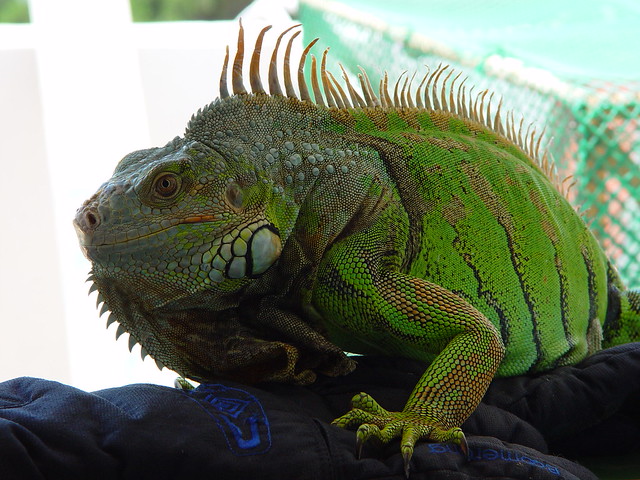 |
| Photo by -Cy- |
1. Acorn Squash- This is a good source of fiber for the iguana. Chop into small pieces so it is easier for the iguana to swallow. This vegetable can be fed to your iguana daily.
2. Apples- This is a great way for the iguana to get some extra water in them. Peel, remove the seeds and chop into small pieces for your pet. Apples should only be fed to your pet iguana on occasion, about once a week.
3. Asparagus- This is a great source of protein for the iguana. Chop into small pieces and feed only occasionally.
4. Bell Peppers- Your pet will love the taste of bell peppers, any color peppers, and they are very healthy for it. These should be chopped fine and can be fed to your pet daily.
5. Berries- A great fruit to feed the iguana, but because of the seeds should only be fed to your pet on occasion.
6. Collard greens- A great vegetable for your pet iguana that is high in calcium. This can be fed to the iguana daily.
7. Green beans- Another great vegetable for the iguana that can be fed to it daily.
8. Mustard greens- Like collard greens, mustard greens are high in calcium and can be fed to your iguana daily.
9. Papaya- A great source of fiber for the iguana. Can be fed to your pet daily.
10. Whole wheat bread- A great treat for your iguana. You should put some water on the bread to get the iguana more water.
You should mix up the iguana's diet on a daily basis so that your iguana can get all the vitamins it needs. By changing different foods on different days also gives the iguana something new to taste on. Note that iguanas are strictly herbivores and should never be given meat as well as some other foods. Avoid all dairy products, eggs and dog/cat food. Feed the iguana the 10 above fruits, vegetables and bread, and you should see your iguana live a happy and healthy life.
2018-10-25
CORAL REEF Aquarium
 |
| 440 l reef tank (Photo credit: Wikipedia) |
Coral reef aquariums require much more care than freshwater tanks or saltwater fish only tanks. Freshwater fish are usually hardier than marine species and therefore a little more forgiving when it comes to water acclimation. It is recommended that only experienced fish keepers with a real commitment to the hobby attempt a coral reef aquarium. A tank containing coral reef life may require several months of cycling before getting the water just right. The water in a coral reef tank must be regulated for lighting, temperature, and ph. Start with tap water and then add a sea salt mix to the water. This type of solution is available at most pet stores.
require much more care than freshwater tanks or saltwater fish only tanks. Freshwater fish are usually hardier than marine species and therefore a little more forgiving when it comes to water acclimation. It is recommended that only experienced fish keepers with a real commitment to the hobby attempt a coral reef aquarium. A tank containing coral reef life may require several months of cycling before getting the water just right. The water in a coral reef tank must be regulated for lighting, temperature, and ph. Start with tap water and then add a sea salt mix to the water. This type of solution is available at most pet stores.
The salinity of the tank should be between 1.023 and 1.004. The ideal temperature for a marine aquarium is between 75 and 79 degrees Fahrenheit. It is also important to test the P.H. of the tank. Ideal P.H. is somewhere between 8.3 and 8.4. Test kits can be purchased online or at your local pet store. The same store will also carry any solutions necessary to adjust the P. H. There is not much wiggle room when it comes to these specific starting points. In order to avoid a costly mistake, it is important to be patient, watch the tank closely, and make sure that you don't introduce any marine life until the tank is absolutely ready.
Once the aquarium is ready, start with anemones and clownfish. They are the hardiest of reef species, and who wouldn't love to have Nemo swimming around in their living room? Monitor the marine life closely. Check the activity levels of the fish, and watch for stress. Stress is the most common cause of sickness in fish. Remember that these creatures may have come directly from the ocean, and it may take a while for them to get acclimated to their new home. Another cause of stress in fish is overcrowding. Make sure there allow about ten gallons of water per one inch of fish. Account for the full-grown size of the fish, not the size of fish when it is purchased.
The incubation period for most sickness in fish is about thirty days. So after about a month, if all is well with the tank and the fish seem to be adjusting well, then it is okay to introduce some new marine life. A mandarin fish or a dwarf angelfish might round out the collection nicely, and they are fairly compatible clownfish. Whenever adding new fish, choose the species carefully for compatibility. The fish should be compatible with water specifics, but also make sure that their food source is compatible. Always remember to be patient when adding new fish.
Give the existing tank members plenty of time to get adjusted before making additions to an aquarium. The best piece of advice is to do research. Make sure that all new purchases will be suitable tank mates for the existing creatures. With a little luck, and a lot of skill you will be on your way to having a reef aquarium that will impress any fishkeeper.
2018-10-24
Basic BETTA FISH Facts
 |
| A male metallic double-tail Betta (Betta splendens) (Photo credit: Wikipedia) |
The Betta splendens, or the Siamese fighting fish, is a native of the slow-moving streams and ponds of Asia. First seen in Cambodia, which was known before as Siam, hence the name Siamese fighting fish, it can also be found in Vietnam, Thailand, and China. Bettas are known to be very aggressive towards other bettas and will fight until their opponent backs down or gets seriously injured just to defend their territory. This behavior has been exploited for entertainment purposes, but these days the aggressive traits of betta fish are often breaded out by the breeders.
Without a doubt, the beautiful colors and flowing fins make the betta a very attractive pet fish. Another reason for their appeal is that they tend to respond to their owners much more than other fish. Their eyesight is phenomenal and they will usually approach the water surface when they see you coming. Male bettas have longer fins while females' fins are shorter. Male bettas are also larger and much more colorful.
The aggressive nature of the betta is the reason why it is difficult to keep them in a single tank without them exhibiting aggression towards each other. Though they attack other bettas, they are surprisingly tolerant of other types of fish and are oftentimes bullied by other aggressive fish. Maybe it's because they do not treat other types of fish as competitors for females.
This trait makes bettas a suitable addition to a community tank, although they will not make good tank mates with just any fish, and they will probably always be happier when alone.
If you are planning to build a community tank, you would be well advised to do some research on compatible fish for a betta.
Another betta fish fact that you might find interesting is their method of breathing. Instead of breathing underwater like most fish, bettas breathe air instead of water with an organ called the labyrinth. That's why you might notice them going up to the surface and opening their mouth every once in a while. For that reason, it's best to keep bettas in an aquarium that is not too high. Their frequent trips to the surface may require too much energy, which would stress them out and make them weaker and thus more susceptible to disease. That's why, even though some aquarium designs may be very appealing to you, if they are too tall, they will not be the best choice for a betta.
A good example would be wall-mounted aquariums. They are very popular with many aquarists because of the ease of maintenance. The Aqua Bella aquariums, for instance, require water changes only once per year. Even though technically appropriate for betta fish, they would not be ideal.
Remember betta's natural home - shallow, warm and still waters of rice paddies. In aquarium terms that translates to 10 inches from the substrate to the surface of the water as the ideal height for a betta.
If you want to keep a betta as a pet, you must always keep in mind that bettas are originally from a tropical climate. In order to keep them healthy, you must replicate the conditions of their natural environment. Water temperatures of around 75 to 85 degrees Fahrenheit should keep the fish comfortable and reduce the chance of parasites. You should also make sure that your water isn't moving too fast in case you have an active filtration system. Bettas are used to slow-moving waters and strong currents might stress it.
Some very popular aquariums have rather strong filters. Be sure to ask about that before your purchase, as not all manufacturers are aware of the needs of bettas in this regard and they sometimes advertise or recommend certain types of filtration for betta fish tanks, even though the current is definitely too strong.
If you would like to deepen your understanding of these beautiful species, betta fish facts can be found all around, from books in the library to Wikipedia entries on the Internet. They are not only entertaining but also informative. Certain facts are also essential to you if you aspire to become a betta fish owner since this knowledge could help you improve your ability to care for your pet fish.
|
2018-10-23
AQUARIUM FISH HEALTH: WHITE SPOT DISEASE, symptom and cure.
 |
| Photo: Wikimedia |
Fish death is one of the main problem that beginner aquarist and even few experts. It’s so frustrating to the extent that most quit keeping life aquarium fish. Most fish deaths are caused as a result of parasites both internal and external types that compete with you fish in the tank. If you watch your aquarium fish often you should be able to discover when they have been infected by this parasite and be able to treat them to avoid fish death. Look out for the following behavioral symptoms in your fish.
- Constant lying on the bottom or hanging at the surface.
- Rubbing of the body against rocks.
- Gasping at the water surface.
- Non-response of feeding
- General dullness and lethargy
- hovering in a corner
- fish swimming with clamps up
White Spot: - the most common of the visible signs is the development of the pinhead-size while sports on the body or fins. This ailment is referred to as white Spot caused by the parasite - Ichthyophthirius Multifillis.
This parasite has a free-swimming stage, which attaches itself to the fish. The most common chemical used in treating infected fishes is Methylene Blue. You could buy a one percent stock solution from a reputable chemist or aquarium shop and apply at 0.8 to 1.0ml per gallon of water. This amount should be added all at once. Repeat after one or two days.
The fishes must remain in this bath until every while spot has disappeared. A water change after treatment is necessary or else prolonged contact with the chemical may affect the fertility of the fish. Aquarists using side filter with activated charcoal should remove this gadget to prevent the coal from absorbing the blue dye.
During treatment, you should use artificial aeration with coarse bubbles near the surface, since a dirty bottom would inactivate the medicament by absorption. A better measure is to remove all dirt from the bottom before treatment.
Methylene Blue is harmless to young fishes and unlike the general belief, it does not affect plants if used in weaker concentration.
2018-10-22
Different Sinking FISH FOOD for DISCUS
 |
| Aquarium - Dried foods for fishes (Photo credit: Wikipedia) |
There are different types of discus fish foods, which mainly contains three categories:
Dry food, frozen food and live discus food. These can be further classified as sinking food, slow sinking food and floating fish food. Since discus, fish are mostly mid-water feeders slow sinking fish food for discus is most preferred.
Different types of sinking fish food for discus are:
Flakes: Flakes come under the category of top floating food but if you pinch them a big before feeding they sink down.
Pellets: Small and mostly round shaped, pellets are both sinking and floating. Giving dry pellets to fish can cause them to bloat, therefore, soak them in water for a little while before feeding.
Granules: These are smaller forms of pellets are can be fed in the same way you feed the pellets.
Wafers and tablets: These are one of the most popular forms of sinking fish food for discus. They have a very well balanced ingredient content. Although they sink rapidly but since they are small enough to be eaten in one bite the fish eat them up quickly. Also, they don't cloud the water.
Gels: These are preprocessed slow sinking food for fish. These then being thawed, then mixed with homemade food or other frozen food and then frozen again to feed the fish. They can be used to give your fish a varied diet.
Slow sinking discus fish food is preferred because then the fish can reach it easily. If the fish sinks too fast then they will not be able to reach it and it will rot in the bottom and can harm the fish. Discus fish follow a routine and therefore you have to keep in mind to feed them at fixed times every day.
Also, since discus fish like to follow a routine, therefore, feed them at regular intervals and give small feedings at a time. They like to eat frequently and hence if you give them to feed only once or twice a day, it will go waste and the fish will starve. Any variation from the routine will make them confused and disrupt their system.
|
Subscribe to:
Posts (Atom)




